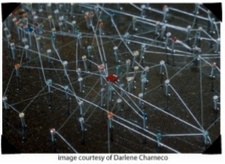Fold

When I was young my father wanted to teach me about space and time. He began by drawing two dots on a piece of paper, one marked 'A' and the other marked 'B'. "What is the shortest distance between these two points?" he asked.
"A line," I told him, proud of myself for knowing that essential mathematical concept.
"In this case, you're not correct," he said, and folded the paper over so that point A touched point B. "The shortest distance between two points is actually a fold, or a bend in space-time, or a wormhole."
When I first began to use the Internet, and then mobile phones, I realized that technology was taking the distance between two people and folding it. Technology was folding space and time so that geography did not matter. And it was doing something more, the online world was providing a way for people to see the inside of each other before they saw the outside.
In the case of Skype, mobile phones, Twitter or Facebook, the shortest distance between two people was often technology. The fold also allows one's social interactions to become multidimensional, creating an environment in which one can connect with multiple people in multiple places at one time.
Instead of walking down the street and seeing a stranger, the Internet allows one's internal thoughts to be displayed. This allows people to connect via interests that might not be expressed in local physical and social geographies.
